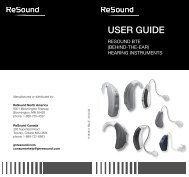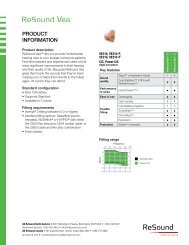ReSound Vea Behind-the-Ear (BTE) User Guide
ReSound Vea Behind-the-Ear (BTE) User Guide
ReSound Vea Behind-the-Ear (BTE) User Guide
You also want an ePaper? Increase the reach of your titles
YUMPU automatically turns print PDFs into web optimized ePapers that Google loves.
Care and maintenance<br />
Your hearing instrument is protected by a layer of protective,<br />
hydrophobic nanocoat material.<br />
Please follow <strong>the</strong> following instructions to prolong <strong>the</strong> durability<br />
of your hearing instruments:<br />
1. Keep your hearing instrument clean and dry. Wipe <strong>the</strong><br />
case with a soft cloth or tissue after use to remove<br />
grease or moisture. Do not use water or solvents, as<br />
<strong>the</strong>se can damage <strong>the</strong> hearing instrument(s).<br />
2. Never immerse hearing instruments in water or o<strong>the</strong>r<br />
liquids, as liquids may cause permanent damage to <strong>the</strong><br />
hearing instruments.<br />
3. Avoid rough handling of hearing instruments or dropping<br />
<strong>the</strong>m on hard surfaces or floors.<br />
4. Do not leave hearing instruments in or near direct heat or<br />
sunlight, such as in a hot, parked car, as excessive heat<br />
can cause damage or deform <strong>the</strong> casing.<br />
5. Do not wear your instrument while showering, swimming,<br />
in heavy rain or in a moist atmosphere such as a steam<br />
bath or sauna.<br />
6. If your instrument does get wet, or if it has been exposed<br />
to high humidity or perspiration, it should be left<br />
to dry out overnight with <strong>the</strong> battery out and <strong>the</strong> battery<br />
compartment open. It is also a good idea to put <strong>the</strong><br />
instrument and battery in a sealed container toge<strong>the</strong>r<br />
with a drying agent (desiccator) overnight. Do not use <strong>the</strong><br />
instrument until it is completely dry. Consult your hearing<br />
care professional as to which drying agent to use.<br />
7. Remove your hearing instrument when applying such<br />
things as cosmetics, perfume, aftershave, hair spray, and<br />
suntan lotion. These might get into <strong>the</strong> instrument and<br />
cause damage.<br />
daily maintenance<br />
It is important to keep your hearing<br />
instrument clean and dry. On a<br />
daily basis, clean <strong>the</strong> hearing instruments<br />
using a soft cloth or tissue.<br />
In order to avoid damage due to humidity or excessive perspiration,<br />
<strong>the</strong> use of a drying kit is recommended. Some drying<br />
kits are electric, and in addition to thoroughly drying out hearing<br />
instruments, <strong>the</strong>y help sanitize.<br />
Cleaning earmolds<br />
1. Remove <strong>the</strong> earmold<br />
and attached tubing<br />
from <strong>the</strong> hearing<br />
instruments prior to<br />
cleaning.<br />
2. Clean <strong>the</strong> earmold using<br />
a mild soap, and rinse with<br />
lukewarm water.<br />
3. After cleaning, dry earmolds thoroughly and remove any<br />
residual water and debris from <strong>the</strong> tubing utilising an air<br />
bulb and wire loop.<br />
Note: <strong>Ear</strong>mold tubing may become stiff, brittle, or discoloured<br />
over time. Contact your hearing care professional regarding<br />
tube changes.<br />
18 19





